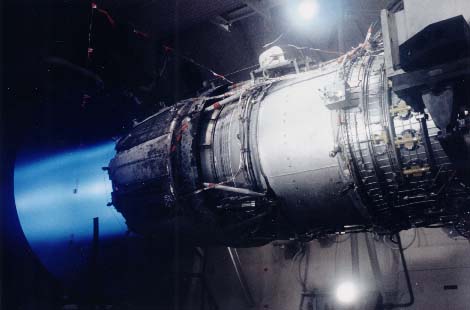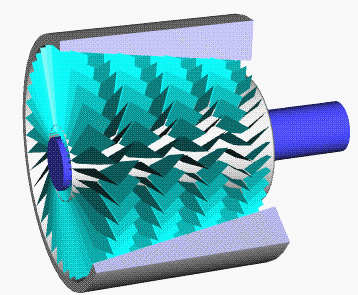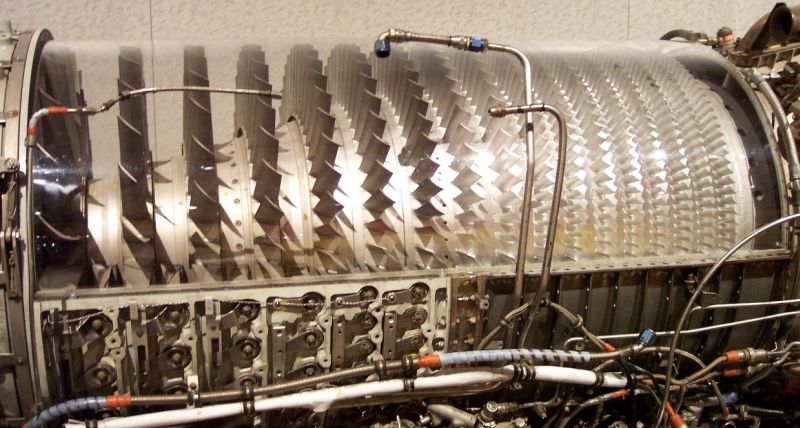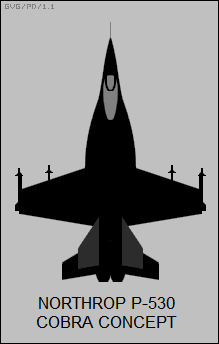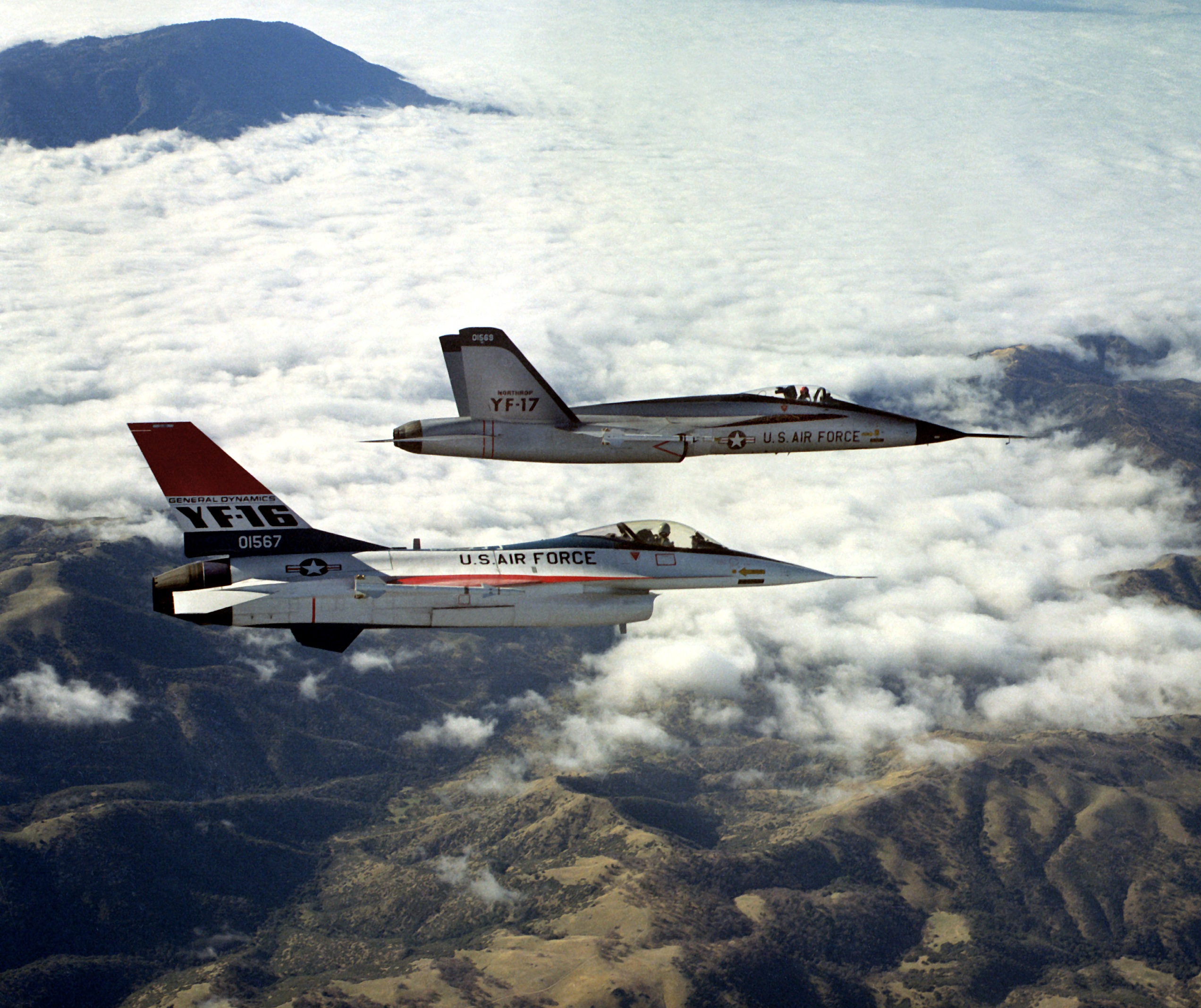|
GE F404
The General Electric F404 and F412 are a family of afterburning turbofan engines in the class (static thrust). The series is produced by GE Aviation. Partners include Volvo Aero, which builds the RM12 variant. The F404 was developed into the larger F414 turbofan, as well as the experimental GE36 civil propfan. Design and development F404 GE developed the F404 for the F/A-18 Hornet, shortly after losing the competition for the F-15 Eagle's engine to Pratt & Whitney, and losing the Lightweight Fighter (LWF) competition to the Pratt & Whitney F100 powered YF-16. For the F/A-18, GE based the F404 on the YJ101 engine they had developed for the Northrop YF-17, enlarging the bypass ratio from .20 to .34 to enable higher fuel economy. The engine was designed with a higher priority on reliability than performance. Cost was the main goal in the design of the engine. GE also analyzed "throttle profiles" and found that pilots were changing throttle settings far more often than eng ... [...More Info...] [...Related Items...] OR: [Wikipedia] [Google] [Baidu] |
WikiProject Aircraft
A WikiProject, or Wikiproject, is a Wikimedia movement affinity group for contributors with shared goals. WikiProjects are prevalent within the largest wiki, Wikipedia, and exist to varying degrees within Wikimedia project, sister projects such as Wiktionary, Wikiquote, Wikidata, and Wikisource. They also exist in different languages, and translation of articles is a form of their collaboration. During the COVID-19 pandemic, CBS News noted the role of Wikipedia's WikiProject Medicine in maintaining the accuracy of articles related to the disease. Another WikiProject that has drawn attention is WikiProject Women Scientists, which was profiled by ''Smithsonian Magazine, Smithsonian'' for its efforts to improve coverage of women scientists which the profile noted had "helped increase the number of female scientists on Wikipedia from around 1,600 to over 5,000". On Wikipedia Some Wikipedia WikiProjects are substantial enough to engage in cooperative activities with outside organization ... [...More Info...] [...Related Items...] OR: [Wikipedia] [Google] [Baidu] |
Turbofan
The turbofan or fanjet is a type of airbreathing jet engine that is widely used in aircraft propulsion. The word "turbofan" is a portmanteau of "turbine" and "fan": the ''turbo'' portion refers to a gas turbine engine which achieves mechanical energy from combustion, and the ''fan'', a ducted fan that uses the mechanical energy from the gas turbine to force air rearwards. Thus, whereas all the air taken in by a turbojet passes through the combustion chamber and turbines, in a turbofan some of that air bypasses these components. A turbofan thus can be thought of as a turbojet being used to drive a ducted fan, with both of these contributing to the thrust. The ratio of the mass-flow of air bypassing the engine core to the mass-flow of air passing through the core is referred to as the bypass ratio. The engine produces thrust through a combination of these two portions working together; engines that use more jet thrust relative to fan thrust are known as ''low-bypass turbofans'', ... [...More Info...] [...Related Items...] OR: [Wikipedia] [Google] [Baidu] |
General Electric F101
The General Electric F101 is an afterburning turbofan jet engine. It powers the Rockwell B-1 Lancer strategic bomber fleet of the USAF. In full afterburner it produces a thrust of more than . The F101 was GE's first turbofan with an afterburner. Development The F101 was developed specifically for the Advanced Manned Strategic Aircraft, which became the B-1A. The F101 powered the four development aircraft from 1970 to 1981. The B-1A was officially cancelled in 1977. However the flight test program continued. was awarded a contract to further develop the F101-102 engine variant. This turbofan eventually powered the B-1B from 1984, entering service in 198 ...[...More Info...] [...Related Items...] OR: [Wikipedia] [Google] [Baidu] |
General Electric F110
The General Electric F110 is an afterburning turbofan jet engine produced by GE Aviation. The engine is derived from the General Electric F101 and shares its core design, and primarily powers tactical fighter aircraft. The F118 is a non-afterburning variant of the F110. The engine is also license-built in Eskisehir, Turkey by TUSAŞ Engine Industries (TEI). Design and development The F110 emerged from an intersection of efforts in the 1970s by General Electric to reenter the U.S. fighter engine market and the U.S. Air Force's desire to address the reliability, longevity, and maintenance issues with the Pratt & Whitney F100 engines that powered its F-15s and F-16s. In 1975, General Electric used its own funds to begin developing the F101X, a derivative of its F101 engine for the B-1 bomber; the F101X would inherit much of the core design while having a smaller fan so that its thermodynamic cycle and thrust was better suited for a fighter engine. The cancellation of the B-1 ... [...More Info...] [...Related Items...] OR: [Wikipedia] [Google] [Baidu] |
Compressor Stall
A compressor stall is a local disruption of the airflow in the compressor of a gas turbine or turbocharger. A stall that results in the complete disruption of the airflow through the compressor is referred to as a compressor surge. The severity of the phenomenon ranges from a momentary power drop barely registered by the engine instruments to a complete loss of compression in case of a surge, requiring adjustments in the fuel flow to recover normal operation. Compressor stall was a common problem on early jet engines with simple aerodynamics and manual or mechanical fuel control units, but has been virtually eliminated by better design and the use of hydromechanical and electronic control systems such as Full Authority Digital Engine Control. Modern compressors are carefully designed and controlled to avoid or limit stall within an engine's operating range. Types There are two types of compressor stall: Rotating stall Rotating stall is a local disruption of airflow within the ... [...More Info...] [...Related Items...] OR: [Wikipedia] [Google] [Baidu] |
General Electric J79
The General Electric J79 is an axial-flow turbojet engine built for use in a variety of fighter and bomber aircraft and a supersonic cruise missile. The J79 was produced by General Electric Aircraft Engines in the United States, and under license by several other companies worldwide. Among its major uses was the F-104 Starfighter, B-58 Hustler, F-4 Phantom II, A-5 Vigilante and IAI Kfir. A commercial version, designated the CJ805, powered the Convair 880, while an aft-turbofan derivative, the CJ805-23, powered the Convair 990 airliners and a single Sud Aviation Caravelle intended to demonstrate to the U.S. market the benefits of a bypass engine over the existing Avon turbojet. In 1959 the gas generator of the J79 was developed as a stationary 10MW-class () free-turbine turboshaft engine for naval power, power generation, and industrial use, called the LM1500. Its first application was in the research hydrofoil . Development Evolution of the variable stator compressor ... [...More Info...] [...Related Items...] OR: [Wikipedia] [Google] [Baidu] |
Northrop YF-17
The Northrop YF-17 (nicknamed "Cobra") is a prototype lightweight fighter aircraft designed by Northrop aviation for the United States Air Force's Lightweight Fighter (LWF) technology evaluation program. The LWF was initiated because many in the fighter community believed that aircraft like the F-15 Eagle were too large and expensive for many combat roles. The YF-17 was the culmination of a long line of Northrop designs, beginning with the N-102 Fang in 1956, continuing through the F-5 family. Although it lost the LWF competition to the F-16 Fighting Falcon, the YF-17 was selected for the new Naval Fighter Attack Experimental ( VFAX) program. In enlarged form, the F/A-18 Hornet was adopted by the United States Navy and United States Marine Corps to replace the A-7 Corsair II and F-4 Phantom II, complementing the more expensive F-14 Tomcat.Jenkins, Dennis R. ''F/A-18 Hornet: A Navy Success Story''. New York: McGraw-Hill, 2000. . This design, conceived as a small and lightw ... [...More Info...] [...Related Items...] OR: [Wikipedia] [Google] [Baidu] |
F-16 Fighting Falcon
The General Dynamics F-16 Fighting Falcon is a single-engine multirole fighter aircraft originally developed by General Dynamics for the United States Air Force (USAF). Designed as an air superiority day fighter, it evolved into a successful all-weather multirole aircraft. Over 4,600 aircraft have been built since production was approved in 1976. Although no longer being purchased by the U.S. Air Force, improved versions are being built for export customers. In 1993, General Dynamics sold its aircraft manufacturing business to the Lockheed Corporation, which in turn became part of Lockheed Martin after a 1995 merger with Martin Marietta. The Fighting Falcon's key features include a frameless bubble canopy for good visibility, side-mounted control stick to ease control while maneuvering, an ejection seat reclined 30 degrees from vertical to reduce the effect of g-forces on the pilot, and the first use of a relaxed static stability/fly-by-wire flight control system that helps ... [...More Info...] [...Related Items...] OR: [Wikipedia] [Google] [Baidu] |
Pratt & Whitney F100
The Pratt & Whitney F100 (company designation JTF22) is an afterburning turbofan engine manufactured by Pratt & Whitney that powers the F-15 Eagle and F-16 Fighting Falcon. Development In 1967, the United States Navy and United States Air Force issued a joint engine Request for Proposals (RFP) for the F-14 Tomcat and the FX, which became the parallel fighter design competition that led to the F-15 Eagle in 1970. This engine program was called the IEDP (Initial Engine Development Program) and was funded and managed out of the Aeronautical Systems Division (ASD) at Wright-Patterson AFB. Under ASD, a Systems Project Office Cadre was assigned to manage both the FX Aircraft and Engine definition phase. The Turbine Engine Division of the Air Force Propulsion Laboratory was employed in a support role to assist ASD Systems Engineering in evaluations of technical risks. Later upon selection of the F-15 the ASD engineering cadre became the F-15 Systems Project Office. The IEDP was cr ... [...More Info...] [...Related Items...] OR: [Wikipedia] [Google] [Baidu] |
Lightweight Fighter
The Lightweight Fighter (LWF) program was a United States Air Force technology evaluation program initiated in the late 1960s by a group of officers and defense analysts known as the " Fighter Mafia". It was spurred by then-Major John Boyd's 'energy-maneuverability' (E-M) theory, which indicated that excessive weight would have severely debilitating consequences on the maneuverability of an aircraft. Boyd's design called for a light-weight fighter with a high thrust-to-weight ratio, high maneuverability, and a gross weight of less than , half that of its counterpart, the McDonnell Douglas F-15 Eagle. It resulted in the development of the General Dynamics YF-16 and Northrop YF-17. Late in the program, in 1974, with the promise of European sales, the Air Force changed the program name to Air Combat Fighter (ACF), and committed to purchasing 650 models of the YF-16, adopted as the F-16 Fighting Falcon. The U.S. Navy adopted a modified version of the YF-17 as the McDonnell Dougl ... [...More Info...] [...Related Items...] OR: [Wikipedia] [Google] [Baidu] |
Pratt & Whitney
Pratt & Whitney is an American aerospace manufacturer with global service operations. It is a subsidiary of Raytheon Technologies. Pratt & Whitney's aircraft engines are widely used in both civil aviation (especially airlines) and military aviation. Its headquarters are in East Hartford, Connecticut.Contact Us ." Pratt & Whitney. Retrieved on January 7, 2011. "Corporate Headquarters Pratt & Whitney 400 Main Street East Hartford, CT 06108." As one of the "big three" aero-engine manufacturers, it competes with and , although it has also formed joint ventures wit ... [...More Info...] [...Related Items...] OR: [Wikipedia] [Google] [Baidu] |
F-15 Eagle
The McDonnell Douglas F-15 Eagle is an American twin-engine, all-weather tactical fighter aircraft designed by McDonnell Douglas (now part of Boeing). Following reviews of proposals, the United States Air Force selected McDonnell Douglas's design in 1969 to meet the service's need for a dedicated air superiority fighter. The Eagle first flew in July 1972, and entered service in 1976. It is among the most successful modern fighters, with over 100 victories and no losses in aerial combat, with the majority of the kills by the Israeli Air Force.Spick 2000, p. 127. The Eagle has been exported to Israel, Japan, and Saudi Arabia. The F-15 was originally envisioned as a pure air-superiority aircraft. Its design included a secondary ground-attack capability that was largely unused. The aircraft design proved flexible enough that an improved all-weather strike derivative, the F-15E Strike Eagle, was later developed, entered service in 1989 and has been exported to several nat ... [...More Info...] [...Related Items...] OR: [Wikipedia] [Google] [Baidu] |

